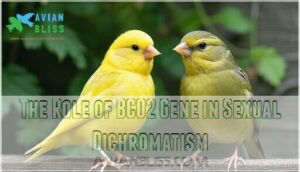This site is supported by our readers. We may earn a commission, at no cost to you, if you purchase through links.
 Male birds flaunt bright colors because it’s nature’s version of peacocking – literally.
Male birds flaunt bright colors because it’s nature’s version of peacocking – literally.
Females consistently choose the flashiest males, making vibrant plumage an evolutionary dating strategy that’s worked for millions of years.
You’re seeing sexual selection in action, where colorful males signal good genes, health, and superior territory-holding abilities.
Those brilliant reds, blues, and yellows aren’t just pretty – they’re advertisements screaming "I’m fit enough to survive with this attention-grabbing outfit."
The brighter the bird, the better his chances of passing on his DNA, as recent genetic discoveries reveal how specific genes control this color dimorphism, explaining why some species break the rules entirely.
Table Of Contents
- Key Takeaways
- Why Are Male Birds More Colorful?
- Sexual Selection and Female Preference
- Male-Male Competition and Color Signaling
- Color as an Indicator of Male Health
- The Role of BCO2 Gene in Sexual Dichromatism
- Evolution of Female Coloration
- Frequently Asked Questions (FAQs)
- Why are male birds more colorful than females?
- Why do male birds have colorful plumage?
- Why are male birds different from female birds?
- Why do birds become more colorful as they age?
- Why do birds mate with colorful feathers?
- Why do birds have bright colors?
- Why are males more colorful?
- Which gender is more beautiful in birds?
- Why are male cardinals more colorful than females?
- Why do male birds have brightly colored feathers?
- Conclusion
Key Takeaways
- You’re witnessing sexual selection in action – females consistently choose the brightest males because vibrant plumage signals superior genes, health, and parenting potential, driving millions of years of colorful evolution.
- Male colors aren’t just pretty – they’re survival advertisements – those brilliant reds, blues, and yellows communicate fitness, territory-holding ability, and genetic quality while helping males intimidate rivals and attract mates.
- It’s actually about females losing color, not males gaining it – recent BCO2 gene research reveals females possess a "color-killing" enzyme that destroys pigment molecules, while males lack this function, explaining why dimorphism exists.
- Bright feathers come with real costs – males trade safety for reproduction success, as their attention-grabbing plumage increases predation risk but maximizes their chances of passing on DNA through female preference.
Why Are Male Birds More Colorful?
When you see a brilliant red cardinal or a stunning peacock, you’re witnessing sexual selection in action.
Male bird coloration evolved because females consistently choose brighter mates, viewing vibrant bird plumage as proof of good genes and health.
This female choice drives visual signaling, where bird colors communicate fitness despite increased predation risk and hormonal control factors.
The diverse colors of birds, such as the Gouldian Finch’s colors, are a demonstration to this.
Sexual Selection and Female Preference
You’ve probably noticed that male cardinals flash brilliant red feathers while females sport more muted brown tones, but have you ever wondered why this dramatic difference exists?
The answer lies in sexual selection, where female birds consistently choose the brightest, most vibrant males as their mates, a process that highlights the importance of brilliant displays in attracting a partner.
Darwin’s Theory
Darwin’s sexual selection theory explains male bird coloration through female preference-driven evolution.
Female birds act as nature’s selective pressure, choosing vibrant males and driving colorful evolution forward.
When females consistently choose vibrant males, colorful traits become evolutionary advantages over generations.
This powerful force creates stunning plumage diversity across species through three key mechanisms:
- Fitness indicators – bright colors signal genetic health to potential mates
- Mate competition – flashy displays help males outcompete duller rivals
- Color evolution – successive generations develop increasingly elaborate ornamentation
Female choice acts like nature’s artist, painting male birds in brilliant hues that maximize reproductive success despite predation risks.
Studies Supporting Female Preference
Research consistently shows that female preference drives sexual selection in birds.
In zebra finches, females choose males with enhanced plumage brightness over duller competitors.
House finch studies reveal females select redder males, viewing vibrant colors as signals of genetic fitness and parenting potential.
Through mate choice, females assess male vitality during courtship displays, leading to greater mating success for colorful males across species.
This is evident in species like cardinals, where male plumage is crimson and preferred by females.
Exceptions to The Rule
Not all bird species follow the typical pattern where males sport the flashiest feathers.
You’ll find fascinating examples of reversed sexual dimorphism, where females steal the spotlight with their vibrant plumage while males remain relatively dull.
- Phalaropes: Colorful females compete for mates while males incubate eggs
- Eclectus Parrots: Bright green males contrast with brilliant red-orange females
- Button Quail: Females display bold patterns during territorial disputes
- Belted Kingfishers: Females wear distinctive rust-colored chest bands
Environmental factors and role reversal drive this pigment expression pattern, proving nature’s rulebook has plenty of colorful exceptions.
Male-Male Competition and Color Signaling
While female preference drives much of male bird coloration, males also compete directly with each other using their bright feathers as weapons in territorial battles.
You’ll see this color-based competition play out when males flash their most vibrant patches to intimidate rivals and claim the best nesting spots, which is a key aspect of territorial battles.
Territorial Displays
Beyond attracting mates, male bird coloration serves as nature’s ultimate power move in territorial defense. When males establish and defend their territories, vibrant plumage becomes their primary weapon of intimidation.
These living billboards announce ownership while deterring rivals through visual displays that can prevent costly physical confrontations. Territorial males strategically position themselves where their colors catch maximum light, creating stunning spectacles that communicate both fitness and determination.
The brightest, most well-maintained plumage signals superior genetics and resource access, making competitors think twice before challenging established boundaries. However, this display effectiveness comes with predation risks, as conspicuous colors attract both rivals and predators.
Signal honesty plays a pivotal role—only genuinely healthy males can maintain such brilliant displays while successfully defending prime real estate. Resource defense becomes more effective when backed by authentic visual proof of strength and vitality.
- A cardinal’s crimson chest blazing against winter branches
- A goldfinch’s electric yellow feathers shimmering in sunlight
- A blue jay’s cobalt wings flashing territorial warnings
- An oriole’s orange flames dancing through green leaves
- A tanager’s scarlet fire burning bright among dark foliage
Bright Badges in Contests
When males clash over territory, bright badges serve as visual cues for contest signaling. These colorful patches communicate dominance without physical confrontation, reducing injury risk through plumage intimidation.
Sexual selection favors males whose coloration effectively deters rivals and attracts mates during courtship displays.
Male bird coloration acts like nature’s warning system—brighter equals stronger.
| Badge Function | Competitive Advantage |
|---|---|
| Color dominance | Intimidates weaker rivals |
| Resource competition | Secures prime territories |
| Intrasexual competition | Reduces costly fights |
Examples in Different Species
Three species showcase how male bird coloration drives territorial competition brilliantly.
You’ll witness these dramatic displays:
- Red-winged blackbirds flash crimson shoulder patches during boundary disputes
- Common pheasants brandish iridescent plumage and red facial wattles in competitive arenas
- Peacocks spread magnificent tail trains with eye-spots to intimidate rivals
These colorful badges aren’t just for attracting mates—they’re weapons in male warfare.
Sexual selection has perfected these visual threats across bird species, creating nature’s most spectacular territorial showdowns.
Color as an Indicator of Male Health
When you see a male cardinal’s brilliant red feathers or a goldfinch’s vibrant yellow plumage, you’re witnessing nature’s health certificate in action.
A male bird’s colorful display tells females everything they need to know about his genetic quality, nutritional status, and ability to thrive in challenging conditions.
Carotenoid Pigments and Diet
Quality matters in regards to dietary carotenoids—these pigments create the stunning reds, oranges, and yellows you see in male plumage.
Birds can’t manufacture carotenoids internally, so they depend entirely on their diet for pigment absorption. Males with access to carotenoid-rich foods develop brighter plumage brightness, signaling superior foraging skills and health to potential mates.
| Food Source | Carotenoid Type | Resulting Color | Health Signal |
|---|---|---|---|
| Berries | Astaxanthin | Bright red | Strong immunity |
| Insects | Lutein | Golden yellow | Good nutrition |
| Seeds | Zeaxanthin | Orange-red | Metabolic health |
| Algae | Beta-carotene | Deep orange | Antioxidant capacity |
This color variation directly reflects male bird traits that females evaluate during mate selection, making diet a vital factor in sexual selection success. To guarantee adequate pigment intake, some breeders use specific bird supplements.
Structural Colors and Health
Carotenoids create vibrant reds and yellows, but structural coloration produces the blues, greens, and iridescent sheens that make male birds truly spectacular.
These feather nanostructures don’t rely on diet influence like carotenoids—they’re self-manufactured masterpieces that serve as reliable health indicators.
Iridescence signaling works like nature’s hologram, with microscopic layers in feathers reflecting specific wavelengths. When you see a hummingbird’s throat flash emerald then ruby, you’re witnessing coloration genetics at work.
Males with superior structural coloration typically boast:
- Stronger immune systems that support complex feather development
- Better genetic quality reflected in precise nanostructure formation
- Enhanced UV reflection patterns invisible to predators but dazzling to females
These plumage colors require significant energy investment, making them honest advertisements of male fitness for mate choice decisions.
Female Assessment of Male Quality
When you watch female birds selecting mates, you’re witnessing sophisticated quality control in action.
Females don’t just pick the flashiest guy – they’re evaluating plumage brightness, pattern complexity, and feather symmetry as health indicators.
These visual cues reveal genetic fitness and parenting potential.
A male’s colorful plumage tells the story of his diet quality, disease resistance, and overall vitality, helping females make informed mate choice decisions for superior genetic quality in their offspring.
Maintaining superior plumage requires attention to various health factors.
The Role of BCO2 Gene in Sexual Dichromatism
Recent research has uncovered a fascinating genetic mechanism behind sexual dichromatism in birds—you’ll be surprised to learn it’s not about males gaining color, but females losing it.
A groundbreaking 2020 study in canaries revealed that females possess an active BCO2 gene that literally destroys the pigment molecules responsible for bright plumage, while males lack this "color-killing" function.
Gene Discovery and Function
Scientists discovered the BCO2 gene as the molecular switch behind bird coloration.
This genetic basis controls an enzyme that breaks down carotenoid pigments, creating dramatic color variations between sexes.
When BCO2 functions normally, it destroys reddish-orange compounds, leaving males with duller feathers.
However, genetic mutations can disable this process, allowing vibrant pigment production.
Hormonal influence and gene regulation fine-tune this system, explaining why genetic mechanisms create such stunning diversity in bird genetics across species.
BCO2 Expression in Canaries
Canary genetics reveal BCO2’s fascinating role in color control.
This gene breaks down carotenoids, creating nature’s pigment degradation system.
Female BCO2 expression differs substantially from males:
- Yellow canaries show low BCO2 activity in feather follicles
- White canaries maintain high BCO2 levels, preventing colorful plumage
- Red-factor birds display intermediate BCO2 expression patterns
- Liver tissues express BCO2 robustly regardless of feather color
This discovery explains how bird genetics shape male birds’ colorful plumage through precise molecular switches.
BCO2 in Wild Bird Species
Across numerous wild bird species, BCO2 variation creates stunning differences in male birds’ colorful plumage.
This genetic basis for bird coloration appears in European serins and house finches, where loss-of-function mutations boost carotenoid accumulation.
The plumage impact varies dramatically between species, but BCO2’s evolutionary significance remains clear—it’s a key player controlling mate attraction through vibrant feathers.
Birds’ vibrant hues are often the result of carotenoid pigments obtained through diet.
Species differences highlight how one gene shapes avian beauty.
Evolution of Female Coloration
While male birds often grab attention with their flashy feathers, female coloration tells its own fascinating evolutionary story that scientists are just beginning to understand.
Recent studies on New World blackbirds reveal that natural selection shapes female plumage in surprising ways, challenging the old assumption that drab females simply avoid predators.
New World Blackbird Study
Through decades of research on New World blackbirds, you’ve likely assumed males drive colorful plumage evolution.
Freeman et al.’s groundbreaking 2019 study analyzing 110 icterid species flipped this assumption. Female blackbirds actually evolved faster than males, creating today’s sexual dimorphism patterns through rapid color changes.
Here’s what makes this discovery remarkable:
- Ancestral females displayed bright colors – many species started with colorful females
- Female color loss exceeded male gains – females shed brightness more rapidly than males acquired it
- Polygynous systems intensified changes – mating competition accelerated female camouflage evolution
- Genetic shifts happened quickly – BCO2 gene mutations enabled rapid plumage transformations
This research reveals survival tradeoffs where female preference for male birds’ colorful plumage coexisted with natural selection favoring female camouflage, reshaping our understanding of sexual dimorphism evolution.
Natural Selection on Female Colors
Natural selection has shaped female bird coloration through powerful evolutionary forces.
While males evolved bright plumage for attracting mates, females faced different pressures entirely.
Predation pressure favors drab females during vulnerable nesting periods, with studies showing cryptically colored mothers achieving higher nest survival rates.
Camouflage needs vary by habitat – ground-nesters require earth-toned mottling while tree-dwellers need bark-like patterns.
This environmental signaling reflects each species’ specific challenges.
Females of some species, like the cardinal, exhibit buff-brown plumage to aid in camouflage.
| Selection Pressure | Female Adaptation | Survival Benefit |
|---|---|---|
| Ground predation | Earth-toned plumage | Reduced nest detection |
| Aerial threats | Mottled patterns | Better canopy camouflage |
| Incubation exposure | Cryptic coloration | Enhanced reproductive success |
Sexual dimorphism results from these competing forces – male ornamentation versus female practicality.
This contrast highlights the different evolutionary paths taken by males and females in response to their environment.
Frequently Asked Questions (FAQs)
Why are male birds more colorful than females?
While you might think bright colors make birds vulnerable, male birds evolved vibrant plumage through sexual selection.
Females prefer colorful mates because bright feathers signal good health, strong genes, and quality parenting potential.
Why do male birds have colorful plumage?
You’ll see male birds sporting bright feathers because sexual selection drives this evolution. Colorful plumage attracts females who prefer vibrant mates, signaling good genes and health despite increased predation risks.
Why are male birds different from female birds?
Sexual dimorphism creates nature’s ultimate fashion show! You’ll find males evolved vibrant plumage through sexual selection, while females developed camouflaged colors for protection during nesting, creating striking differences between sexes.
Why do birds become more colorful as they age?
Birds don’t universally become more colorful with age. Young males often develop brighter plumage as they mature, reaching peak coloration when they’re ready to compete for mates and reproduce successfully.
Why do birds mate with colorful feathers?
Colorful feathers act like nature’s dating profiles – you’re drawn to vibrant plumage because it signals genetic fitness, health, and strong parenting potential in potential mates.
Why do birds have bright colors?
Darwin’s theory suggests bright plumage evolved through sexual selection, but you’ll find it’s more complex.
Males develop vivid colors to attract mates, signaling genetic fitness and health to choosy females who prefer vibrant partners.
Why are males more colorful?
You’ll find males sporting flashier feathers because they’re competing for female attention. Bright colors signal good genes and health to potential mates, helping males stand out in nature’s dating game.
Which gender is more beautiful in birds?
Beauty’s in the eye of each beholder, but you’ll typically notice males strutting around like living rainbows while females sport earth-toned wardrobes for survival’s sake.
Why are male cardinals more colorful than females?
Male cardinals sport vibrant red feathers to attract mates through sexual selection.
You’ll notice females choose brighter males because their coloration signals good genes and health.
While females stay brown for camouflage during nesting.
Why do male birds have brightly colored feathers?
You’ll notice these bright feathers help males attract mates during breeding season. Sexual selection drives this colorful display – females prefer vibrant plumage because it signals good genes and health.
Conclusion
Nature’s fashion show reveals that regarding the question of why male birds are more colorful, it’s all about winning the ultimate prize – reproduction.
You’ve witnessed millions of years of evolution fine-tuning this brilliant strategy, where vibrant plumage signals genetic quality, health, and territorial dominance.
The BCO2 gene discovery confirms what Darwin suspected: bright colors aren’t accidents but carefully crafted advertisements for survival and mating success in the competitive avian world.












